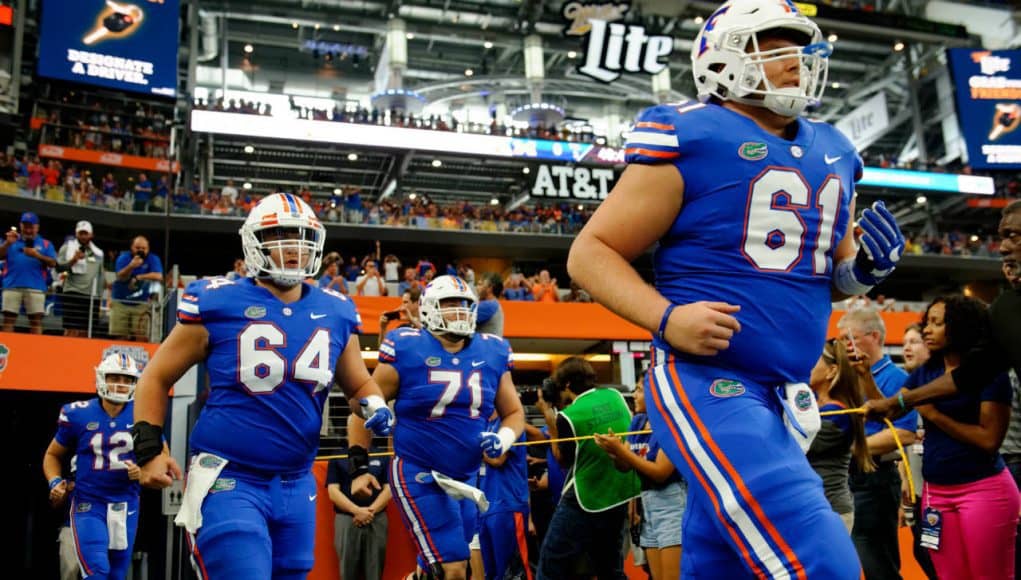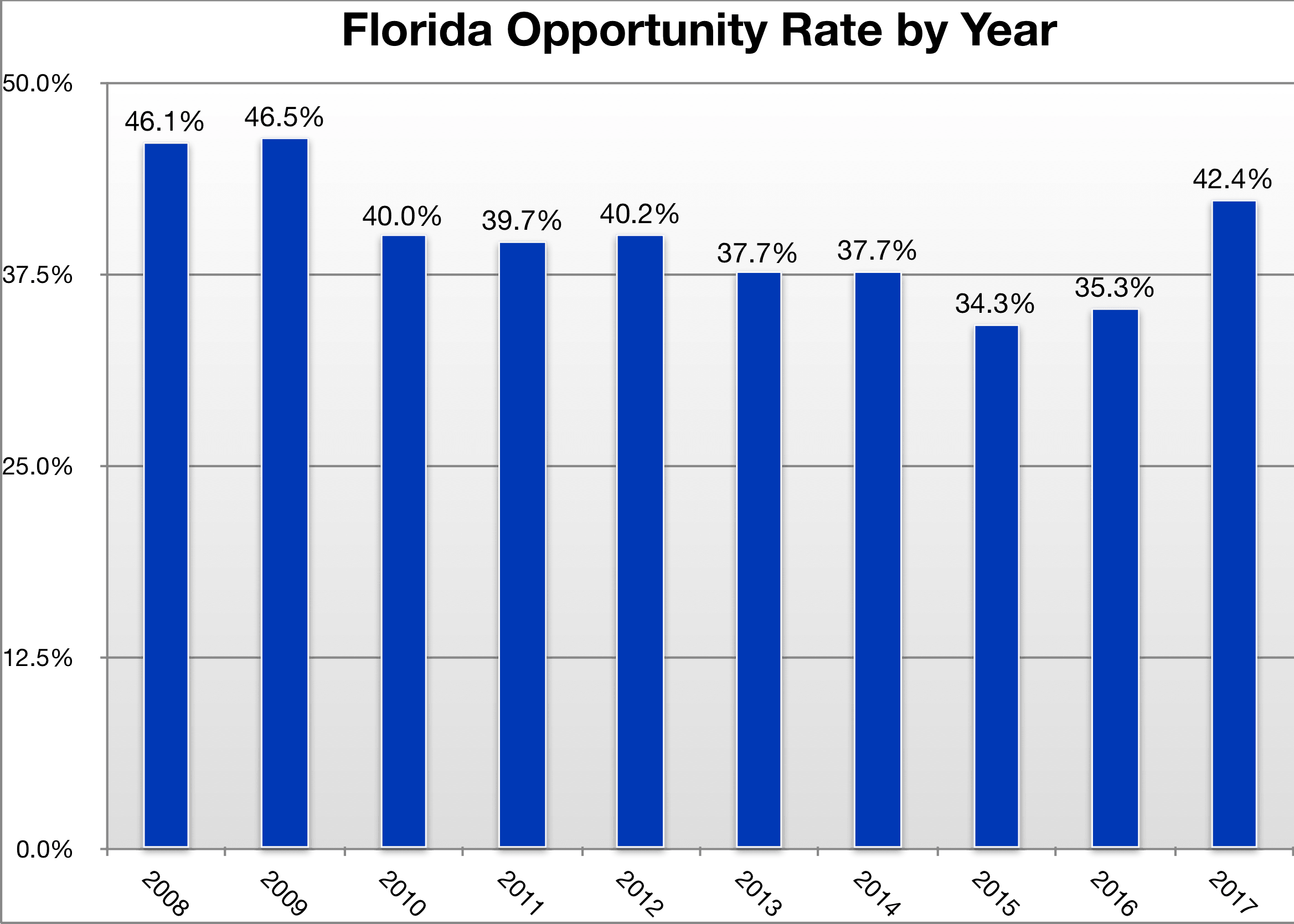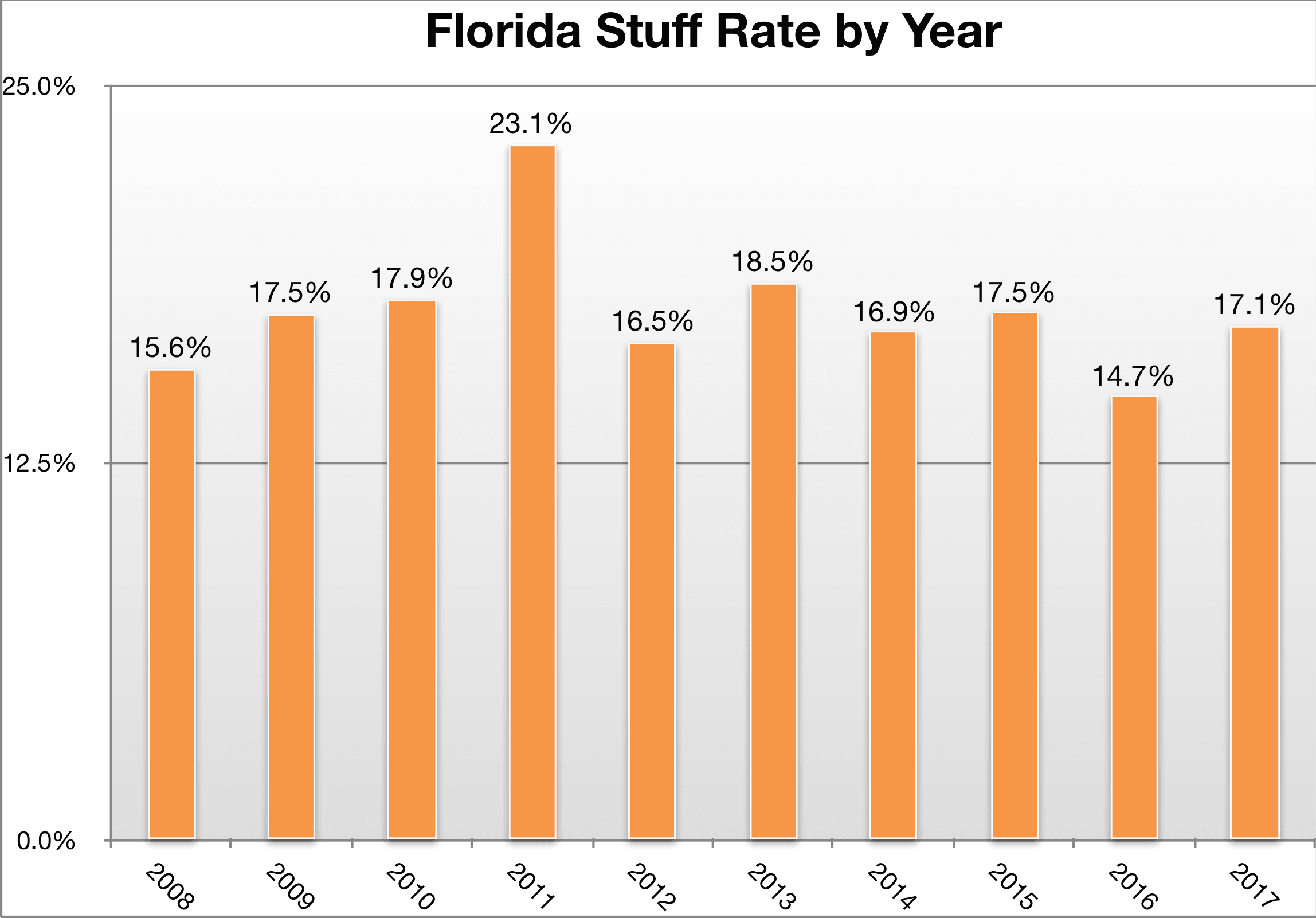It seemed to me that the Florida offensive line was better in 2017 than in the preceding couple of years. It wasn’t up to where it was back in the Urban Meyer glory days, but it seemed like some combination of new line coach Brad Davis and a healthy number of returning starters did make a difference for the better.
Having looked at a couple of aspects of the line in terms of the run game, I’m not entirely sure how much the line got better. It’s a puzzle that shows how hard it can be to isolate the individual aspects of the very team-oriented game of football.
First up, I’m going to discuss opportunity rate. The philosophy behind this measure is that the first five yards beyond the line of scrimmage on a running play are the responsibility of the offensive line. Opportunity rate, then, is the percentage of plays where the ball carrier goes at least five yards.
It’s not perfect, of course. There are situations like 3rd & 1 where getting five yards isn’t really the point of the play. A tight end might miss a block that prevents the back from getting five yards. There are stretch run plays where the blocking of the receivers is the most important factor. Even accepting these shortcomings, I do think opportunity rate has some merit because most of the blocking on most of the run plays is done by the offensive line.
In 2017, Florida’s opportunity rate made a much-needed turnaround.
The national average for opportunity rate is about 39%. The old Steve Addazio lines of 2008-09 were well above average in this measure, but the line slipped to being right about average in 2010 and stayed there. Then in the third year under Will Muschamp, the line went to being below average and stayed there into the Jim McElwain era. As offensive line recruiting was one of the biggest shortcomings of the Muschamp era, this all makes some sense.
My intuition then about the line improving last year seems to have some merit with the team’s opportunity rate being solidly above average for the first time since 2009. Looking at the opportunity rate of individual players muddies the water a bit, though.
In 2016 with that subpar showing, the opportunity rates of the three primary running backs were all below 40%: Jordan Scarlett’s was 34.6%, Lamical Perine’s was 33.0%, and Mark Thompson’s was 38.2%. These line up with the team rate.
In 2017, Perine led the team in carries and had an opportunity rate of 34.6%. That’s exactly the same as Scarlett’s from the prior year and not significantly different than his own rate. Thompson was again third in carries and had an opportunity rate of 39.7%. His rate improved by nearly the same 1.6 percentage points as Perine’s did; it’s better, but not by that much.
One difference from 2016 came from Malik Davis. His opportunity rate was 48.1%. Just shy of half of his carries went for at least five yards, as opposed to a sliver over a third of Perine’s going for more than five yards.
Now, removing Davis’s carries only brings the team’s opportunity rate down to 41.1%. It doesn’t fall further because there are a number of other players who had some rushing attempts: Adarius Lemons mostly in garbage time late in the year, Feleipe Franks on scrambles, Malik Zaire on called rushes and scrambles, Kadarius Toney taking direct snaps, a few random attempts for Brandon Powell and Dre Massey. They collectively had a healthy opportunity rate of 54.1%. If you want to take out Lemons because more than half his carries were against UAB, the rate actually improves to 55.4%. The miscellaneous portion of the rushing game was good at getting at least five yards on carries, and that is a marked difference over 2015 and 2016.
The other measure I want to highlight today is stuff rate. Simply, it’s the percentage of carries that were stopped for no gain or a loss.
Last year was a regression compared to 2016 in this regard, but it was still better than the national average of about 19.3%. As I have covered in a couple of past entries here, Scarlett’s ability to elude and run through tackles and therefore avoid being stuffed is a big reason why the rate was so low last year.
It also was lower last year, however, because that line just seems to have been better at preventing run game stuffs. Perine’s stuff rate in 2016 was 14.4% but in 2017 was 17.6%. Thompson’s stuff rate two years ago was 16.7% and last year was 19.0%.
Again, Davis shines through as a running back. His stuff rate was a mere 8.9%, which is noticeably better than even Scarlett’s 12.4% from 2016. In fact, five of the seven times he was stopped for no gain or a loss all came against Texas A&M and its disruptive front; his stuff rate was a mere 2.5% against all other opponents.
Here I suspect the ball carrier has a bit more of an effect. Lemons’s stuff rate, which again came mostly in the UAB game or in garbage time, was 15.8%. Both quarterbacks had stuff rates above 24%, though them throwing the ball away more on scrambles would’ve helped that a bit.
Only Toney, who has even better elusive moves than Davis does, had a lower stuff rate at 7.1% on his 14 carries. His one and only time getting stuffed was against Georgia and its tough front.
So while opportunity rate was a case of Perine and Thompson basically being worse than everyone else, stuff rate was a case of Davis and Toney basically being better than everyone else. The common thread in both is that Davis was really good last year. Toss in his clearly superior yards per carry rate, and he was unquestionably the best of the three primary backs last year.
But that’s ball carriers. What about the line?
I think it’s difficult to say for sure given what happened down the stretch, when both injuries set in and the head coach got fired. Looking at the advanced box scores, stuff rate is really where that showed up. The rates were 20% against Missouri, 22% against South Carolina, and a ghastly 35% against Florida State. That actually is better than Mizzou’s season-long rate of 25.7%, though the others are worse than South Carolina’s 19.9% and FSU’s 24.3%.
Making similar comparisons throughout the season, the only really bad rushing performance aside from those last couple was the one against Michigan. The Wolverines manhandled the line, which was kind of their thing as they were top ten nationally in a lot of rushing defense categories. The Gators really ran the ball well against LSU, did well against A&M when not being stuffed, and actually ran it solidly against Georgia (though it was more or less a blowout from the start). They feasted as was appropriate against Kentucky and Vandy.
So I will say the line did improve over 2016, though holding the caveat that we have a small sample size to draw from. The team only had 11 games, of which just six were played before the reports of the head coach’s eventual firing began to spread. Starters began to go down in the season’s final month, and the last game only saw one opening week starter in the same place as then (Fred Johnson at right guard). Certainly, having a better ball carrier in Davis helped them out as well.
It should be encouraging, then, that all six players who regularly saw the field before the injuries set in are back. There is a decent shot in the arm coming with JUCO transfer Noah Banks arriving plus three former 4-stars joining the mix in Texas transfer Jean DeLance, redshirt freshman TJ Moore, and 2018 signee Richard Gouraige. Last year, there were only six guys that could be trusted and otherwise we were hoping for no injuries. This year, there can actually be true competition at more than just one of the guard spots.
Last year’s line was OK but not great, but it was better than 2016’s in opportunity rate. Plus taking out the FSU game, which was an interim staff’s last contest and was played with a completely jumbled line, brings the season-long stuff rate down to 15.1% — not that much higher than 2016’s 14.7%.
To be sure, the hope for the 2018 line improving again is just that — unsubstantiated hope that the players, John Hevesy, and Nick Savage all must put in hard work to fulfill. But, I can at least say that hope exists.




